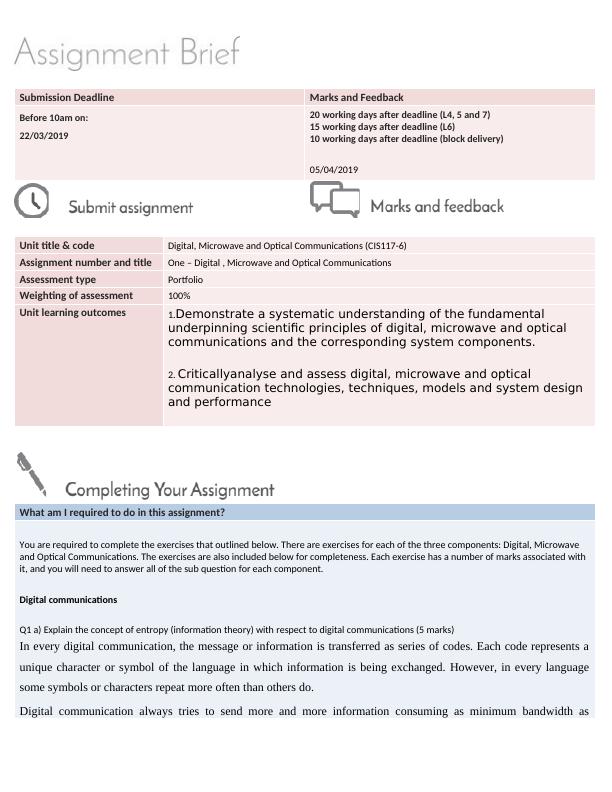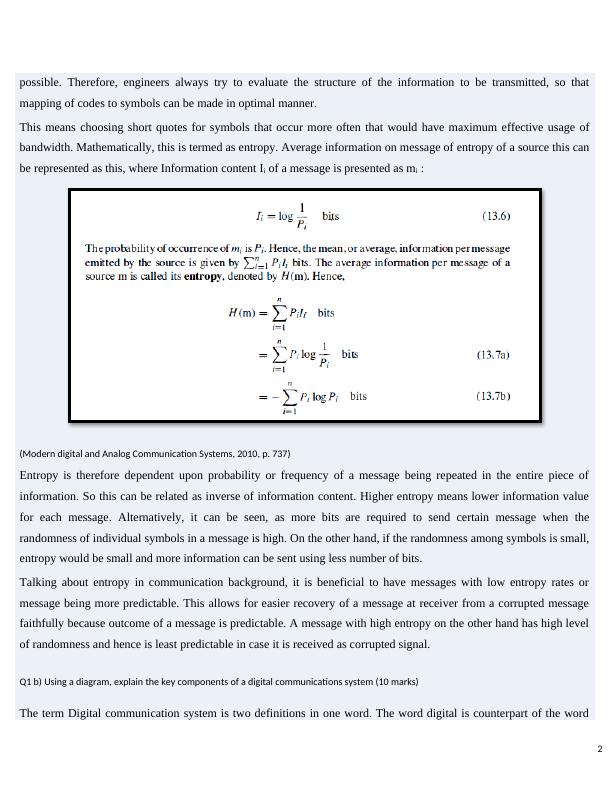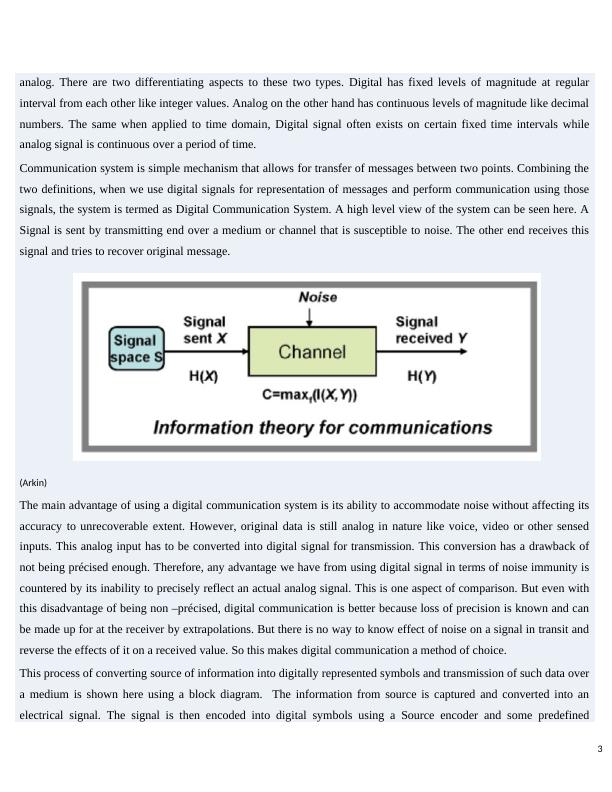Digital, Microwave and Optical Communications Assignment
You are required to complete exercises in digital, microwave and optical communications and answer questions related to entropy and key components of a digital communications system.
19 Pages4265 Words204 Views
Added on 2023-04-08
About This Document
This assignment focuses on digital, microwave, and optical communications. It covers topics such as entropy in digital communications, key components of a digital communications system, and different types of digital modulation. The assignment requires completing exercises for each component and answering sub-questions. The unit code is CIS117-6, and the assignment type is a portfolio. The submission deadline is 05/04/2019.
Digital, Microwave and Optical Communications Assignment
You are required to complete exercises in digital, microwave and optical communications and answer questions related to entropy and key components of a digital communications system.
Added on 2023-04-08
ShareRelated Documents
Submission Deadline Marks and Feedback
Before 10am on:
22/03/2019
20 working days after deadline (L4, 5 and 7)
15 working days after deadline (L6)
10 working days after deadline (block delivery)
05/04/2019
Unit title & code Digital, Microwave and Optical Communications (CIS117-6)
Assignment number and title One – Digital , Microwave and Optical Communications
Assessment type Portfolio
Weighting of assessment 100%
Unit learning outcomes 1.Demonstrate a systematic understanding of the fundamental
underpinning scientific principles of digital, microwave and optical
communications and the corresponding system components.
2. Criticallyanalyse and assess digital, microwave and optical
communication technologies, techniques, models and system design
and performance
What am I required to do in this assignment?
You are required to complete the exercises that outlined below. There are exercises for each of the three components: Digital, Microwave
and Optical Communications. The exercises are also included below for completeness. Each exercise has a number of marks associated with
it, and you will need to answer all of the sub question for each component.
Digital communications
Q1 a) Explain the concept of entropy (information theory) with respect to digital communications (5 marks)
In every digital communication, the message or information is transferred as series of codes. Each code represents a
unique character or symbol of the language in which information is being exchanged. However, in every language
some symbols or characters repeat more often than others do.
Digital communication always tries to send more and more information consuming as minimum bandwidth as
Before 10am on:
22/03/2019
20 working days after deadline (L4, 5 and 7)
15 working days after deadline (L6)
10 working days after deadline (block delivery)
05/04/2019
Unit title & code Digital, Microwave and Optical Communications (CIS117-6)
Assignment number and title One – Digital , Microwave and Optical Communications
Assessment type Portfolio
Weighting of assessment 100%
Unit learning outcomes 1.Demonstrate a systematic understanding of the fundamental
underpinning scientific principles of digital, microwave and optical
communications and the corresponding system components.
2. Criticallyanalyse and assess digital, microwave and optical
communication technologies, techniques, models and system design
and performance
What am I required to do in this assignment?
You are required to complete the exercises that outlined below. There are exercises for each of the three components: Digital, Microwave
and Optical Communications. The exercises are also included below for completeness. Each exercise has a number of marks associated with
it, and you will need to answer all of the sub question for each component.
Digital communications
Q1 a) Explain the concept of entropy (information theory) with respect to digital communications (5 marks)
In every digital communication, the message or information is transferred as series of codes. Each code represents a
unique character or symbol of the language in which information is being exchanged. However, in every language
some symbols or characters repeat more often than others do.
Digital communication always tries to send more and more information consuming as minimum bandwidth as

possible. Therefore, engineers always try to evaluate the structure of the information to be transmitted, so that
mapping of codes to symbols can be made in optimal manner.
This means choosing short quotes for symbols that occur more often that would have maximum effective usage of
bandwidth. Mathematically, this is termed as entropy. Average information on message of entropy of a source this can
be represented as this, where Information content Ii of a message is presented as mi :
(Modern digital and Analog Communication Systems, 2010, p. 737)
Entropy is therefore dependent upon probability or frequency of a message being repeated in the entire piece of
information. So this can be related as inverse of information content. Higher entropy means lower information value
for each message. Alternatively, it can be seen, as more bits are required to send certain message when the
randomness of individual symbols in a message is high. On the other hand, if the randomness among symbols is small,
entropy would be small and more information can be sent using less number of bits.
Talking about entropy in communication background, it is beneficial to have messages with low entropy rates or
message being more predictable. This allows for easier recovery of a message at receiver from a corrupted message
faithfully because outcome of a message is predictable. A message with high entropy on the other hand has high level
of randomness and hence is least predictable in case it is received as corrupted signal.
Q1 b) Using a diagram, explain the key components of a digital communications system (10 marks)
The term Digital communication system is two definitions in one word. The word digital is counterpart of the word
2
mapping of codes to symbols can be made in optimal manner.
This means choosing short quotes for symbols that occur more often that would have maximum effective usage of
bandwidth. Mathematically, this is termed as entropy. Average information on message of entropy of a source this can
be represented as this, where Information content Ii of a message is presented as mi :
(Modern digital and Analog Communication Systems, 2010, p. 737)
Entropy is therefore dependent upon probability or frequency of a message being repeated in the entire piece of
information. So this can be related as inverse of information content. Higher entropy means lower information value
for each message. Alternatively, it can be seen, as more bits are required to send certain message when the
randomness of individual symbols in a message is high. On the other hand, if the randomness among symbols is small,
entropy would be small and more information can be sent using less number of bits.
Talking about entropy in communication background, it is beneficial to have messages with low entropy rates or
message being more predictable. This allows for easier recovery of a message at receiver from a corrupted message
faithfully because outcome of a message is predictable. A message with high entropy on the other hand has high level
of randomness and hence is least predictable in case it is received as corrupted signal.
Q1 b) Using a diagram, explain the key components of a digital communications system (10 marks)
The term Digital communication system is two definitions in one word. The word digital is counterpart of the word
2

analog. There are two differentiating aspects to these two types. Digital has fixed levels of magnitude at regular
interval from each other like integer values. Analog on the other hand has continuous levels of magnitude like decimal
numbers. The same when applied to time domain, Digital signal often exists on certain fixed time intervals while
analog signal is continuous over a period of time.
Communication system is simple mechanism that allows for transfer of messages between two points. Combining the
two definitions, when we use digital signals for representation of messages and perform communication using those
signals, the system is termed as Digital Communication System. A high level view of the system can be seen here. A
Signal is sent by transmitting end over a medium or channel that is susceptible to noise. The other end receives this
signal and tries to recover original message.
(Arkin)
The main advantage of using a digital communication system is its ability to accommodate noise without affecting its
accuracy to unrecoverable extent. However, original data is still analog in nature like voice, video or other sensed
inputs. This analog input has to be converted into digital signal for transmission. This conversion has a drawback of
not being précised enough. Therefore, any advantage we have from using digital signal in terms of noise immunity is
countered by its inability to precisely reflect an actual analog signal. This is one aspect of comparison. But even with
this disadvantage of being non –précised, digital communication is better because loss of precision is known and can
be made up for at the receiver by extrapolations. But there is no way to know effect of noise on a signal in transit and
reverse the effects of it on a received value. So this makes digital communication a method of choice.
This process of converting source of information into digitally represented symbols and transmission of such data over
a medium is shown here using a block diagram. The information from source is captured and converted into an
electrical signal. The signal is then encoded into digital symbols using a Source encoder and some predefined
3
interval from each other like integer values. Analog on the other hand has continuous levels of magnitude like decimal
numbers. The same when applied to time domain, Digital signal often exists on certain fixed time intervals while
analog signal is continuous over a period of time.
Communication system is simple mechanism that allows for transfer of messages between two points. Combining the
two definitions, when we use digital signals for representation of messages and perform communication using those
signals, the system is termed as Digital Communication System. A high level view of the system can be seen here. A
Signal is sent by transmitting end over a medium or channel that is susceptible to noise. The other end receives this
signal and tries to recover original message.
(Arkin)
The main advantage of using a digital communication system is its ability to accommodate noise without affecting its
accuracy to unrecoverable extent. However, original data is still analog in nature like voice, video or other sensed
inputs. This analog input has to be converted into digital signal for transmission. This conversion has a drawback of
not being précised enough. Therefore, any advantage we have from using digital signal in terms of noise immunity is
countered by its inability to precisely reflect an actual analog signal. This is one aspect of comparison. But even with
this disadvantage of being non –précised, digital communication is better because loss of precision is known and can
be made up for at the receiver by extrapolations. But there is no way to know effect of noise on a signal in transit and
reverse the effects of it on a received value. So this makes digital communication a method of choice.
This process of converting source of information into digitally represented symbols and transmission of such data over
a medium is shown here using a block diagram. The information from source is captured and converted into an
electrical signal. The signal is then encoded into digital symbols using a Source encoder and some predefined
3

quantization algorithms like PCM. This low rate digital data is then further encoded to be suitable for transmission
over a channel. This involves addition of error correction/ detection codes and other header information to the original
message packet. Finally, we get a bit stream that is used to modulate the actual channel. Modulation is process of
altering at least one of the three features of a channel, namely its amplitude, Frequency or phase or any combination of
these. Once channel encoded bit stream is used to alter channel signal, the modulated signal is transmitted over a
medium.
Explanation of the key
components illustrated
in the figure 1.1
above:
1. Input
Transducer:
The source of
data can be
simple or
digital, for
example
simple: sound or video signal, computerized: like print signal. It is a device called transducer which converts
over one type of energy or signal into another type of energy. The transducer is situated at the input side and
output side of the communication framework. The transducer that is situated at the information side of the
communication framework is called input transducer. For the most part, the input transducer changes over the
non-electrical flag (sound signal or light signal) into an electrical signal. The best case of an input transducer is
the microphone which is put between the data source and the transmitter area. An amplifier is a gadget which
changes over your voice signals (sound signals) into electrical signals.
2. Source Encoder:
The signal delivered by source is changed over into digital signal comprises of 0′s and 1's. For this we need
source encoder. We should jump at the chance to use as couple of binary digits as conceivable to speak to the
signal. In such a way this effective portrayal of the source yield results in next to zero redundancy. This
grouping of binary digits is called data sequence. The process of efficiently and significantly converting the
output of analog or digital source into a sequence of binary digits is known as source encoding.
4
over a channel. This involves addition of error correction/ detection codes and other header information to the original
message packet. Finally, we get a bit stream that is used to modulate the actual channel. Modulation is process of
altering at least one of the three features of a channel, namely its amplitude, Frequency or phase or any combination of
these. Once channel encoded bit stream is used to alter channel signal, the modulated signal is transmitted over a
medium.
Explanation of the key
components illustrated
in the figure 1.1
above:
1. Input
Transducer:
The source of
data can be
simple or
digital, for
example
simple: sound or video signal, computerized: like print signal. It is a device called transducer which converts
over one type of energy or signal into another type of energy. The transducer is situated at the input side and
output side of the communication framework. The transducer that is situated at the information side of the
communication framework is called input transducer. For the most part, the input transducer changes over the
non-electrical flag (sound signal or light signal) into an electrical signal. The best case of an input transducer is
the microphone which is put between the data source and the transmitter area. An amplifier is a gadget which
changes over your voice signals (sound signals) into electrical signals.
2. Source Encoder:
The signal delivered by source is changed over into digital signal comprises of 0′s and 1's. For this we need
source encoder. We should jump at the chance to use as couple of binary digits as conceivable to speak to the
signal. In such a way this effective portrayal of the source yield results in next to zero redundancy. This
grouping of binary digits is called data sequence. The process of efficiently and significantly converting the
output of analog or digital source into a sequence of binary digits is known as source encoding.
4

End of preview
Want to access all the pages? Upload your documents or become a member.
Related Documents
Digital Communications: Entropy and Components of a Digital Communication Systemlg...
|15
|2441
|423
IS 302 CHAPTER 3 MINI CASElg...
|7
|855
|67
